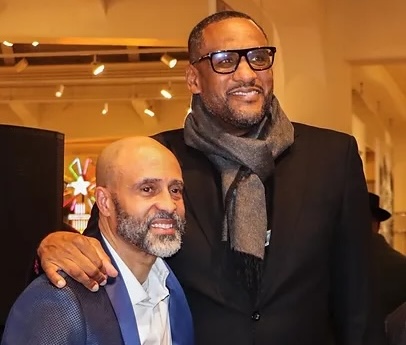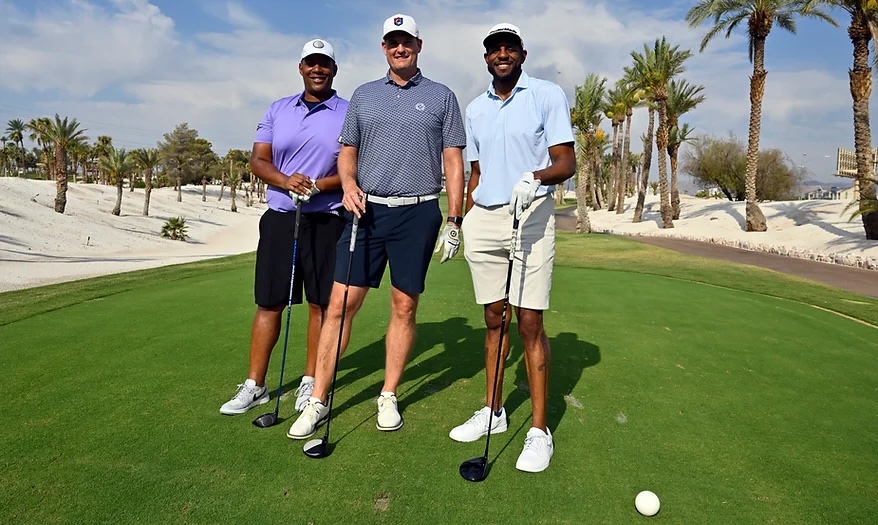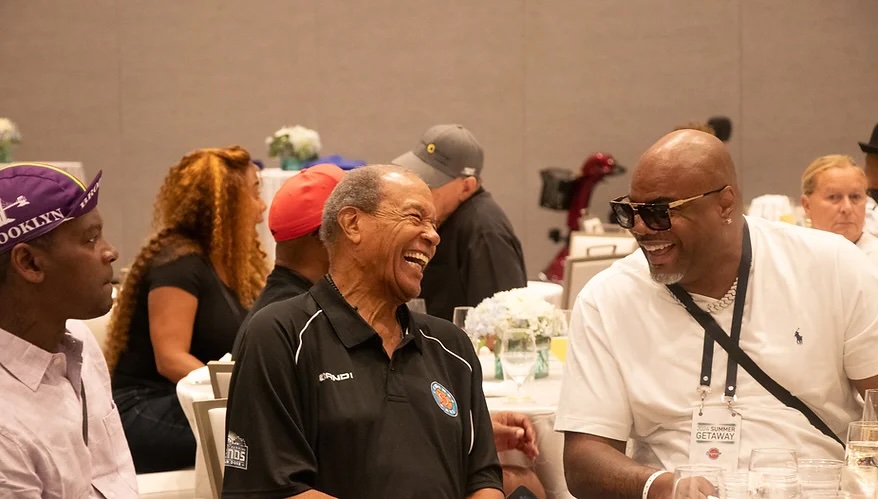Charles “Choo” Smith, Jr., the current chairman at the National Basketball Retired Players Association, isn’t used to running a fundamental offense and competing for championships. His job was to perfect dribbling in a seated position, bouncing the ball between opponents’ legs, and of course, spinning the sphere on his finger.
The Harlem Globetrotters joined the NBRPA in 1996. Fast forward to 2023, when Smith became the first Globetrotter elected as the organization’s chairman. The role involves learning more about the players, listening to their ideas and understanding their needs as they transition from high-profile athletes to everyday people.
“People make billions and billions of dollars off us playing ball,” Smith said. “When I come to a city, the hotels benefit, the restaurants benefit, the schools benefit, the mayor benefits, so think about that revenue. Right then and there, I mean something.”
This value –– referring to the social and economic benefits generated by players during their careers –– drives the current and future initiatives at the NBRPA.
By leveraging their basketball careers and the organization’s business partnerships, members are using their platforms to give back to communities, build new partnerships and raise awareness of the NBRPA.
Legends Care is one initiative that Smith and the NBRPA are encouraging members to take part in. The program is dedicated to working in communities and mentoring the youth. For example, members can attend Full Court Press, a one-day basketball clinic for underserved boys and girls, ages 8 to 18, where they focus on teaching both basketball and life skills.
“Because you’re a role model, you need to reach back and talk to some of these young people,” said Dave Bing, one of the NBRPA’s five founders. “They’re going to go through some of the same things that we went through growing up, and you can help them not to fall into the same holes that we fell into.”
Smith wants members to help young people stay out of those pitfalls. He challenges them, especially those who thrived financially during their playing careers, to be role models by inspiring and educating the next generation.
“The biggest thing is getting in their respective communities,” Smith said, “because they have the money that they make, they have the exposure and they have the brand recognition.”

The NBRPA is also increasingly advocating for women’s basketball. Since welcoming retired WNBA players into the organization in 2013, former WNBA player and current NBRPA Director Rushia Brown is now focused on increasing membership among women.
“When the women enter the room, we bring a different dynamic as far as our ability to communicate the things that we have experienced,” Brown said.
Those varying experiences helped former President and CEO Scott Rochelle, who served until August 2024, and the NBRPA board understand how they can fully support its women.
“We really do have a tremendous number of engaged and active former WNBA players that provide feedback, information and knowledge about what their needs actually are,” Rochelle said.
Hall of Famer Nancy Lieberman is one woman who has consistently played a role in communicating those needs. Lieberman was the first woman to sit on the organization’s board and has since used her relationships to not only create partnerships, but also encourage more women to join the NBRPA.
“I spent the first third of my life learning, the middle part of my life earning, and at this stage in my life, I’m returning and giving back to the game in a meaningful way,” Lieberman said. “Not winning MVPs and winning trophies and championships. Those matter, but what I’m doing now is so much more sustainable and enjoyable because I know it’s going to really affect the game for decades.”
Mike Bantom played in the NBA for nine years, once scoring 38 points on 76% shooting against the Milwaukee Bucks. After retiring, he transitioned into the business side of the league for 30 years, most recently serving as the executive vice president of basketball operations. Now a director at the NBRPA, Bantom has seen both sides of the table when it comes to players’ awareness of transitioning into retirement, a challenge the organization currently faces.
He believes progress needs to be made in terms of unifying the NBRPA with the NBA and National Basketball Players Association. Too often, Bantom said, they look at the same challenges “from different angles” and duplicate programs rather than collaborating on them together. For example, Bantam cites the rookie transition program, which advises first-year players on various topics, including money management, relationships and physical health.
He identifies Andre Iguodala, a former NBA champion and current executive director of the National Basketball Players Association, as a key resource when trying to “unite” these efforts.
“I think (he) has a lot more empathy for the ideas that we’re talking about,” Bantom said, “but (he) also realizes now that some of the things that they’re funding, and that they’re doing for players in their post-career lives, might be better located in our organization.”

Iguodala declined to comment for this story, but Bantom said the NBRPA is actively collaborating with the National Basketball Players Association to promote programs such as Legends Care, health screenings and annual NBRPA events.
Smith also points to the NBA as the third part of the triangle to fully expose the NBRPA. He and NBA Commissioner Adam Silver recently had an hour-and-a-half conversation, discussing how to combine efforts so players become more aware of the NBRPA and its offerings.
“Some players don’t even know what retired players are all about,” Smith said. “How do we get that messaging to them and how do we educate young players on how important the older players are? Because those guys played through so much and didn’t make that much money, but they made the league exciting.”
One way the NBRPA is trying to educate current players, and market its organization, is through social media. In 2020, the NBRPA launched Legends Media & Entertainment, a storytelling initiative allowing members to update followers about their careers and lives. The organization uses its social media platforms to post a weekly “Legends Mixtape” highlight reel, announce player retirements, share members’ new career endeavors and promote podcasts featuring its members.
Another key component of the initiative is the podcast “Legends Lounge with Trill Withers.” Currently featuring 97 episodes, the podcast has hosted former Hall of Fame players such as Charles Barkley, Lisa Leslie, Grant Hill, Isiah Thomas and Tracy McGrady, who discuss both their basketball and post-basketball lives.
Even before creating Legends Media & Entertainment, the NBRPA began the Legends Magazine in 2018. New issues are released three times a year, featuring a former player on the cover and relevant stories inside. The summer 2024 release focused on Olympic stories in anticipation of the Paris Olympics, with gold medalist and WNBA champion Seimone Augustus on the cover and 1992 Dream Team member Clyde Drexler reminiscing about the Barcelona Olympics.
Bing hopes that in five years, there will be at least 3,000 members telling their stories and a full-fledged plan with the NBA and National Basketball Players Association on how to make the most of its retired players. Spencer Haywood, an NBA champion and former ABA MVP, believes the NBRPA can be like the third leg of a barstool, doing its part to keep the seat upright.
“We are not just people who are like, ‘We got through the league and now we got our richness and we don’t care,’” Haywood said. “We do care, and we really care for each other.”

Haywood and Bing are two Hall of Famers who did most of their playing in the 1970s, both successfully creating second acts of life afterwards. As NBRPA board members, they strive to help other former players do the same.
“All of a sudden, you’re no longer this star athlete with this high visibility,” Bing said. “You don’t have access, you haven’t made a bunch of friends over the years that you’ve played, except your teammates.”
Sure, the dribbling and dunking may come to an end. But the NBRPA’s goal, among others, is to help players understand that the locker room still exists. Not for lacing up sneakers or putting on a jersey, but for the familiarity. The NBRPA embodies that camaraderie, uniting those who share the journey from professional athletes to retired players.
The post After The Last Shot, Part 5: The NBRPA’s present efforts and future goals appeared first on ClutchPoints.
